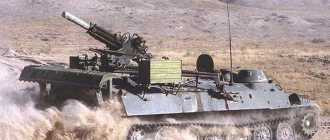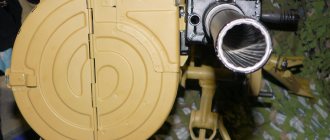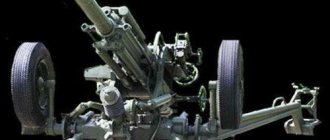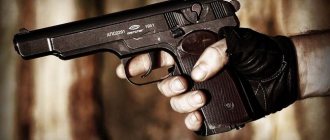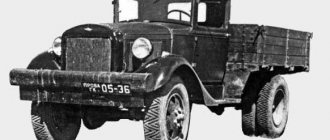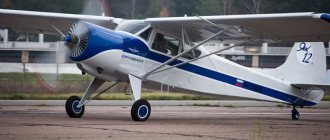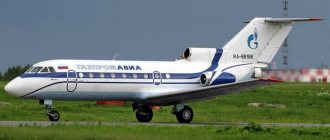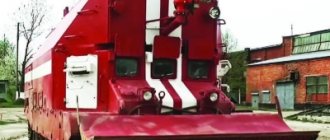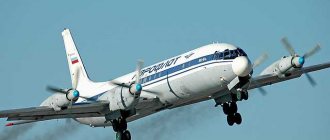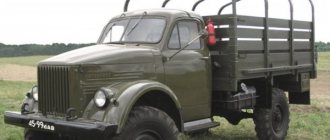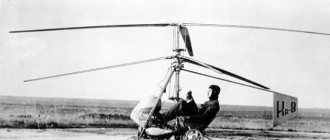The Soviet school of building armored wheeled vehicles has long and glorious traditions. We have come a long way from the newcomer wheeled BTR-40 to the modern infantry support combat vehicle, the BTR 82A armored personnel carrier. The newest Russian armored personnel carriers are the last word in the class of lightly armored military equipment. These formidable and fast armored vehicles are capable of solving a huge range of tasks, possessing excellent capacity, high maneuverability and powerful weapons.
BTR-80A - video
Externally, the BTR-82A is indeed very similar to the BTR-80, but fundamentally it is a completely different vehicle. Despite the fact that it is 400 kg heavier than its predecessor (due to the replacement of the 14.5 mm KPVT machine gun with an automatic 30 mm 2A72 cannon), the maneuverability and maneuverability of the BTR-82A is higher. First of all, due to the use of a more powerful KamAZ 740.14-300 engine, the index indicates a power of 300 hp.
Also, the BTR-82A is equipped with modern driveshafts with end splines, shock absorbers with increased energy intensity and, most importantly, new wheel gearboxes (Soviet gearboxes had congenital defects due to the use of fundamentally outdated globoid gears).
The cross-country ability of the BTR-82A is also increased thanks to the use of drive axles with a gear-locked differential in the transmission, and the locking is completely forced (the principle of operation is the same as in all-wheel drive vehicles). To increase the service life of the transfer case, it uses the principle of constant gear engagement.
With all the technical innovations, the overall layout of the BTR-82A remained the same as that of the BTR-80. The control compartment is located in the front part of the vehicle, the airborne combat compartment is in the middle, and the engine and transmission compartment is in the stern. Crew - three people: commander, driver and gunner, landing force - 7 soldiers in full modern equipment.
The level of ballistic protection of the BTR-82A remains the same - bulletproof. However, it has added internal anti-fragmentation Kevlar protection (this works if the main armor is penetrated). An additional bonus from installing Kevlar is reduced noise levels and improved thermal insulation. The latter is important in conditions of both the Far North and southern heat.
Mine protection is also enhanced in comparison with the BTR-80 by 20% (according to some sources, by 50%) - through the use of special energy-absorbing mats, similar to those used in the Isotrex Phantom armored personnel carrier (United Arab Emirates). At the same time, we should not forget that we are talking about anti-personnel mines: the BTR-82A does not have the MRAP level of mine protection.
On the BTR-82A, boarding and disembarking are traditionally done through double-leaf side doors (the upper door folds forward in the direction of travel, and the lower one becomes a step, which allows motorized riflemen to land on the move). Two more landing hatches are located in the roof. The driver and commander have individual hatches directly above their heads. Opposite the seats in the troop compartment there are ball installations for firing from personal weapons, and two more hatches for firing at the upper hemisphere are in the upper landing hatches. In addition, the hull has a number of hatches and hatches for access to the engine, transmission and winch.
A number of sources indicate the presence of modern anti-compression, so-called “suspended” seats for troops, which reduce the risk of injury to soldiers when an armored personnel carrier is blown up by a mine. However, their installation requires a vertical travel reserve of 200 mm (this is why modern MRAPs have “high ceilings”). In the body of the BTR-82A, designed in the last century, there are simply no extra two tens of centimeters, so the seats in it, although new, are not anti-compression.
But the BTR-82A is equipped with an improved fire detection and extinguishing system. It is also important that the filter-ventilation unit, which protects the crew from the damaging factors of nuclear, biological and chemical weapons, can also work as a regular air conditioner.
As a result, the Russian BTR-82A in 2014 entered the top 10 best armored personnel carriers according to the influential international magazine Army Technology - in terms of protection, firepower and mobility. Along with it, the top ten included the Finnish Patria, the German Boxer, the Swiss Piranha V, the Austrian Pandur II, the American Stryker, the Turkish ARMA and AV8, the Singaporean Terrex (developed by the Irish company Timoney) and the Ukrainian BTR-4.
So far, in addition to the Russian army, the BTR-82A is in service with the Kazakh army. However, the popularity and wide distribution of the BTR-80 in the world (perhaps not the same as that of the Kalashnikov assault rifle, but quite comparable - from the CIS countries to NATO countries and from Asia to Africa) allows us to assume with a high degree of probability that the “deep modification” will be in demand on the global arms market.
And since, as practice shows, Soviet and Russian equipment has been in use in third countries much longer than American equipment, the BTR-82A will almost certainly remain in service for a very long time.
Modifications
BTR-82A - modification with a 30-mm 2A72 cannon in the BPPU module.
BTR-82A1 (BTR-88) - a modernized BTR-82, equipped with a remote-controlled combat module developed by the Burevestnik Central Research Institute with a 30-mm automatic cannon and a 7.62-mm machine gun
BTR-82AM - BTR-80 upgraded to the level of BTR-82A. Modernization is carried out during major overhauls at repair plants.
BTR-82V is an option for the Russian Guard.
BTR-87 - a deep modernization of the BTR-82A, has a completely new armored hull with a front-mounted engine compartment and a rear-mounted compartment for paratroopers. Developed by Military Industrial Company LLC (GAZ Group) and mainly intended for export. It was first shown in June 2015 at the international military-technical forum "Army-2015" in Kubinka.
Vehicles based
Typhoon-M is an anti-sabotage combat vehicle (index 15TS56M) created on the basis of the BTR-82 and designed to protect mobile missile systems and units of the Strategic Missile Forces.
Combat use
- year 2014. According to Armament Research Services, BTR-82AM were used in the East of Ukraine on the side of the separatists. Ukrainian Defense Minister Valeriy Geletey accused the Russian Federation of supplying this type of equipment to the conflict zone. — 2015. At the end of August 2015, the Syrian army published a video of an BTR-82A. The coloring of the vehicles matched those used in the Russian army. Observers speculate that the vehicles were taken from Russian army stocks and delivered to Syria on the Russian large landing ship Nikolai Filchenkov.
Story
The main purpose of the BTR 82A is landing. Therefore, the main characteristics of the vehicle are speed, maneuverability and maneuverability. In the event of a collision with the enemy, the BTR 82A has powerful high-precision weapons, which provides significant support for the landing troops with covering fire.
The BTR 80 is a well-tested and studied vehicle that went through the war in Afghanistan and participated in many other conflicts. The main disadvantages are weak armor protection and insufficient firepower. When creating a modern armored personnel carrier of the 21st century, new requirements for vehicles were also taken into account. In December 2009, the first BTR 82A was produced at the Arzamas plant in the Nizhny Novgorod region. In 2011, the vehicles entered service with the Southern Military District (southern military district). In 2013, the BTR 82A was adopted by the Russian Army. Widely used in motorized rifle troops and marines during landing.
Performance characteristics of the BTR-82A
Crew, people: 3 Troops, people: 7 Years of production: 2011 - present V.
Weight of BTR-82A
— 15.4 tons
Dimensions of BTR-82A
— Length: 7580 mm — Width: 2985 mm — Height: 3025 mm — Track: 2440 mm — Ground clearance: 475 mm
Armament of the BTR-82A
— Gun type: rapid-fire 30 mm 2A72 gun — Machine gun: 7.62 mm PKTM machine gun in BPPU module — Sights: all-day TKN-4GA
Engine BTR-82A
— Engine type: KAMAZ-740.14‑300 — Engine power, l. pp.: 300
Speed BTR-82A
— Maximum speed on the highway: 100 km/h — Speed afloat: 9 km/h — Cruising range on the highway: 600 km — Cruising range on dirt roads: 200 – 500 km — Max. elevation angle: 30 degrees - Ditch width: 2 meters - Vertical barriers: wall 0.5 m
Armor
The internal surfaces of the hull of the BTR 82A are equipped with anti-fragmentation multilayer protection made of synthetic material, the properties of which resemble Kevlar. Floor protection is provided by high-quality mine-resistant mats, which reduce the negative consequences of explosions under wheels. Each layer that forms the mat has a set of specific properties, which as a result provides reliable protection. In addition to mechanical protection, multilayer mats also dampen the impact of the wave generated during an explosion. Special suspensions for the crew and landing seats also help combat the blast wave.
Project evaluation
The BTR-82 and BTR-82A armored personnel carriers are certainly a big step forward compared to its predecessor, the BTR-80. The new vehicles have higher firepower, their security and vehicle mobility have been somewhat improved. However, it’s hard to call the BTR-82A a “breakthrough.” In essence, this is the good old BTR-80 with a new combat module, a more powerful engine and a redesigned chassis.
The armored personnel carrier retains the old layout of the Soviet vehicle, which can easily be attributed to one of its main shortcomings.
Due to the rear location of the engine and transmission compartment, the exit for the paratroopers had to be left on the side. In addition, it is quite narrow and uncomfortable. Most modern cars of this class have a spacious exit at the rear.
The crew seats are not particularly comfortable. If the driver is killed or wounded, getting him out of the workplace will be very problematic. The quality of visibility from the driver’s seat (especially to the rear) raises no less questions. The troop compartment of an armored personnel carrier is cramped; there are no energy-absorbing seats, which are an almost constant attribute of armored personnel carriers today.
The protection of the machine, especially from the effects of a blast wave, is also insufficient.
Currently, the Arzamas Machine-Building Plant is working on creating several more modifications of the BTR-82. However, it should be noted that the line of Soviet armored vehicles BTR-60/70/80 is obsolete and no modernization can change this fact. To give the army a truly modern vehicle, it will have to be developed from scratch.
Confrontation of electronic “brains”
An armored personnel carrier of the 21st century is not only a powerful “heart engine” or a strong modular body. These are also advanced electronic “brains”. For example, the Stryker has a digital C4ISR system built into it. It includes two radios, an electromagnetic radiation warning system, overview video monitors and satellite navigation. If necessary, the commander or gunner can look at the LCD monitor with a view “from the gun barrel.” On the second screen you can load terrain maps, command messages, display “pictures” from reconnaissance drones or satellite geotitles.
The entire body of the M1126 Stryker is literally crammed with sensors. Data about the environment and internal state of the vehicle flows into the central computer and is displayed on the commander's monitor in real time. Everything is recorded - from drizzling rain or a flat tire to through penetration of an armored hull.
The electronics of the BTR-82A are more modest. The domestic armored personnel carrier's assets include the TRON-1 topographic orientation system. With its help, the commander receives the vehicle’s coordinates via autonomous and satellite channels directly into the TKN-AI surveillance devices. If necessary, the system will tell you where the nearest destination or control point is. Another advantage of this system is laser illumination, which will “see” and “guide” the enemy at a distance of up to three kilometers.
The new digital radio station R-168-25-U2 is much better and more comfortable than its analog predecessor, which was installed on the “eightieth” model armored personnel carrier.
© mil.ru
The Russian armored personnel carrier is much cheaper than its American “brother.”
However, we must admit that in electronic brains our car is inferior to the overseas Stryker.
The place and role of armored personnel carriers in the Soviet Army
The armored vehicles of the BA family available in the Red Army on the eve of the war could not fully become a reliable vehicle for infantry. The design of these armored vehicles was not suitable for transporting soldiers in conditions of fire contact with the enemy. The situation began to change only with the advent of Lend-Lease armored personnel carriers into service with the Red Army. From overseas, the Soviet Union received half-tracks M2 and M3, but the most popular armored personnel carrier of the Red Army with American registration was the wheeled M3A1 Scout Car. During the war years, the Americans supplied the USSR with 3,340 of these vehicles under Lend-Lease.
It would be a stretch to say that the American vehicles were full-fledged armored personnel carriers, but in difficult wartime conditions, the appearance of these vehicles played a significant role in increasing the combat effectiveness of Soviet rifle units. In addition to real military-technical assistance, the supply of overseas armored personnel carriers put useful engineering and technical information into the hands of the Soviets. The first post-war developments of Soviet engineers were exactly like American models. First, in the late 40s, the first domestic wheeled armored vehicle BTR-40 appeared. Then the development of armored transporters based on our own developments began.
Fire from all calibers
It didn't work out with the armor, maybe the Russian armored vehicle will be lucky with the weapons? The first glance, and an immediate advantage: instead of a large-caliber KPVT, a 30-mm cannon protrudes menacingly from the turret. Electric drives and a stabilizer in two planes allow you to “water” fire on the move. But KPVT hasn’t gone away either! Moreover, it is paired with a Kalashnikov tank machine gun. So a barrage of three calibers at 2,000 rounds per minute can “peck” almost any light armored vehicle.
© mil.ru
BTR-82A are omnivorous - they absorb both domestic cartridges and NATO trophies equally well.
The BTR-82A barrels are omnivorous - they absorb both domestic cartridges and NATO trophies equally well.
The American armored counterpart of the “infantry” modification (Infantry Combat Vehicle) has more modest weapons. On the light turret there is a remote-controlled M2 Browning machine gun of 12.7 mm caliber or the smaller M240 caliber. The shooter has a thermal imager and a television camera with a zoom lens at his disposal. A laser range finder is synchronized with machine gun barrels. With an accuracy of 2.5 meters, it determines a target at a distance of up to six kilometers.
Another weapon alternative for the Stryker is the Mk19 automatic 40mm grenade launcher with 448 grenades. This is enough to cover any village or trench, but it is useless in the fight against armored vehicles.
© defense.gov
The Stryker has more modest weapons.
We deliberately did not consider heavily armed versions of the M1126 Stryker, such as the mortar-based M1129 Mortar Carrier Vehicle or the super-heavy M1128 Mobile Gun System with a 105 mm anti-tank gun. These vehicles go beyond the concept of armored personnel carriers and are mobile firing points.
So the conclusion is clear: the basic Stryker model is inferior to its Russian opponent in terms of firepower.
Exploitation
Even before its official adoption in Russia in 2010, the BTR-82A was ordered by the armed forces of Kazakhstan. 70 armored vehicles were delivered there. And since 2011, Russian troops also began to switch to new armored personnel carriers. In 2022, the number of operational BTR-82A units exceeded 1,400 units. It is worth noting that these are not only “newly produced” cars. Old BTR-80s are upgraded to BTR-82 standard during major overhauls. Such armored personnel carriers receive the designation BTR-82AM.
It is interesting that although the “machine gun” BTR-82 was considered the basic version, there is no information that such armored personnel carriers were delivered anywhere.
Moreover, it is not even listed in the product lists on the Arzamas Machine-Building website. Obviously, it is not currently being produced and the main model should still be considered the BTR-82A with “cannon” armament.
After the BTR-82A was put into service, some publications rushed to proclaim it “the best in the world” (even if the BTR-90 had previously been certified in the same way).
And, upon closer examination, “ninety” fit this definition more than “eighty-two.” Of course, the adoption of the BTR-82A made it possible not to write off old armored personnel carriers, but to improve their performance during overhauls. On the other hand, the “ninetieth” still had more powerful weapons and better protection.
A possible explanation for the abandonment of a more modern vehicle in favor of modernizing the old one could be the emergence of the promising Boomerang family of armored personnel carriers. Indeed, there is no point in expanding the production of new equipment if an even more advanced one is already “on the way.” But if the Boomerangs, following the Armata tank, are considered too expensive, the Russian army may remain for a long time improved, but not at all new, BTR-82A.
Armament
The basic armored personnel carrier BTR-82 retained the weapon system first introduced on the BTR-60PB. This is a large-caliber (14.5 mm) KPVT machine gun and a coaxial PKT of 7.62 mm caliber. The high armor penetration of the KPVT allows it to hit light armored vehicles, but its capabilities are not enough to combat more protected targets or to defeat infantry in shelters.
The BTR-82A is significantly more powerfully armed. Its turret module is equipped with a 30 mm 2A72 automatic cannon designed by Gryazev and Shipunov. This weapon differs from the 2A42 cannon (used, in particular, on the BTR-90 armored personnel carrier) in the principle of its automation. A gun powered by a long barrel stroke. It became possible to install even on light equipment - the recoil was reduced so much. On the other hand, the rate of fire dropped.
The gun can use all 30x165 mm ammunition designed for the 2A42.
These also include armor-piercing sub-caliber projectiles that penetrate 47 mm inclined armor at ranges of up to 1 km. The effective firing range of high-explosive fragmentation shells exceeds 3 km. Selective power allows you to instantly switch between two belts loaded with different types of ammunition.

